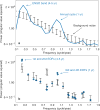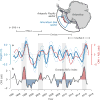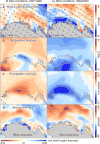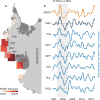Response of Pacific-sector Antarctic ice shelves to the El Niño/Southern Oscillation
- PMID: 29333198
- PMCID: PMC5758867
- DOI: 10.1038/s41561-017-0033-0
Response of Pacific-sector Antarctic ice shelves to the El Niño/Southern Oscillation
Abstract
Satellite observations over the past two decades have revealed increasing loss of grounded ice in West Antarctica, associated with floating ice shelves that have been thinning. Thinning reduces an ice-shelf's ability to restrain grounded-ice discharge, yet our understanding of the climate processes that drive mass changes is limited. Here, we use ice-shelf height data from four satellite altimeter missions (1994-2017) to show a direct link between ice-shelf-height variability in the Antarctic Pacific sector and changes in regional atmospheric circulation driven by the El Niño-Southern Oscillation. This link is strongest from Dotson to Ross ice shelves and weaker elsewhere. During intense El Niño years, height increase by accumulation exceeds the height decrease by basal melting, but net ice-shelf mass declines as basal ice loss exceeds lower-density snow gain. Our results demonstrate a substantial response of Amundsen Sea ice shelves to global and regional climate variability, with rates of change in height and mass on interannual timescales that can be comparable to the longer-term trend, and with mass changes from surface accumulation offsetting a significant fraction of the changes in basal melting. This implies that ice-shelf height and mass variability will increase as interannual atmospheric variability increases in a warming climate.
Conflict of interest statement
Competing financial interests The authors declare no competing financial interests.
Figures













References
-
- Church JA, et al. Climate Change 2013: The Physical Science Basis. In: Stocker TF, et al., editors. Contribution of Working Group I to the Fifth Assessment Report of the Intergovernmental Panel on Climate Change. 2013. pp. 1137–1177.
-
- Fretwell P, et al. Bedmap2: improved, ice bed, surface and thickness datasets for Antarctica. The Cryosphere. 2013;7:375–393.
-
- Bamber JL, Riva REM, Vermeersen BLA, LeBrocq AM. Reassessment of the Potential Sea-Level Rise from a Collapse of the West Antarctic Ice Sheet. Science. 2009;324:901–903. - PubMed
-
- Favier L, et al. Retreat of Pine Island Glacier controlled by marine ice-sheet instability. Nat. Clim. Change. 2014;4:117–121.
-
- Joughin I, Smith BE, Medley B. Marine Ice Sheet Collapse Potentially Under Way for the Thwaites Glacier Basin, West Antarctica. Science. 2014;344:735–738. - PubMed
Grants and funding
LinkOut - more resources
Full Text Sources
Other Literature Sources
Miscellaneous
